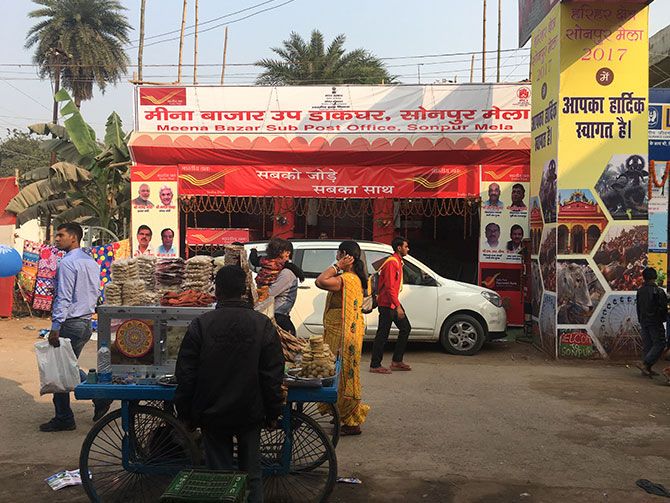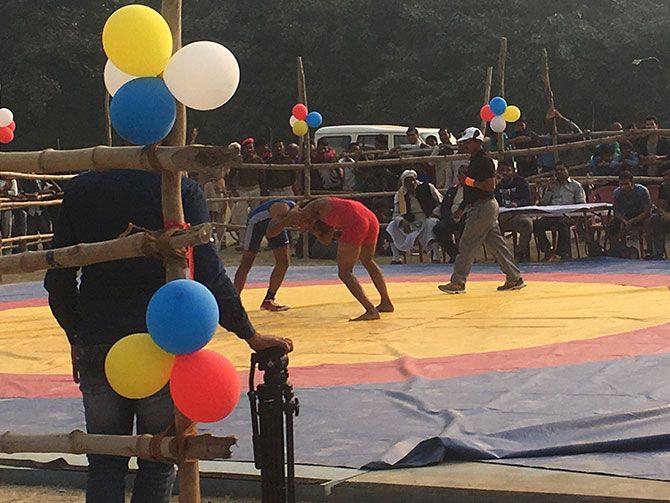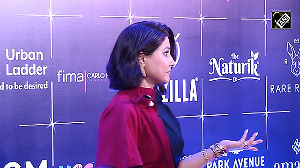Every year, for thousands of years, the Sonepur Mela, transforms a small rural town in north Bihar into a giant fair.
Rediff.com's Archana Masih spent a day in the rural fair that once drew Chandragupta Maurya, Akbar, Shivaji, Rani Laxmibai and Kunwar Singh to buy elephants and horses for their armies -- and is something you may not have seen before.
All Photographs: Seema Pant
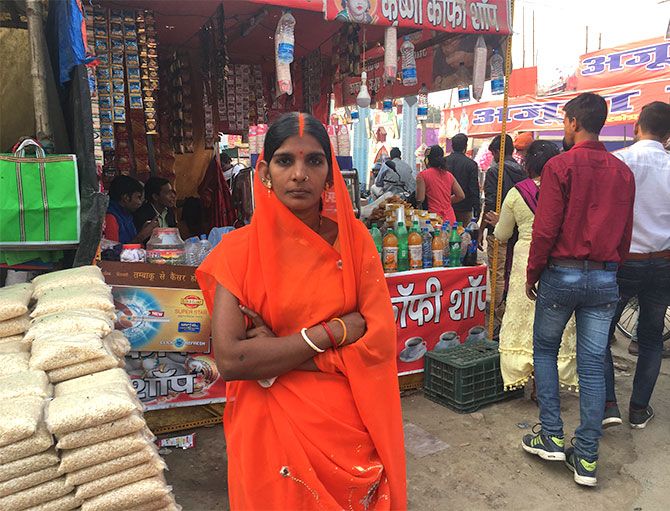
Just as the year dies out, Sonepur, a small town in north Bihar, bursts into life.
"Sonepur is for the mela and the mela is for Sonepur," says Sudhir Kumar, the sub divisional officer, the senior most government official in the subdivision.
On the first two days of the holy dip in the Gandak river, around 500,000 people converge on the banks which doubles the number of the local population.
"Sonepur is for the mela and the mela is for Sonepur," says Sudhir Kumar, the sub divisional officer, the senior most government official in the subdivision.
On the first two days of the holy dip in the Gandak river, around 500,000 people converge on the banks which doubles the number of the local population.
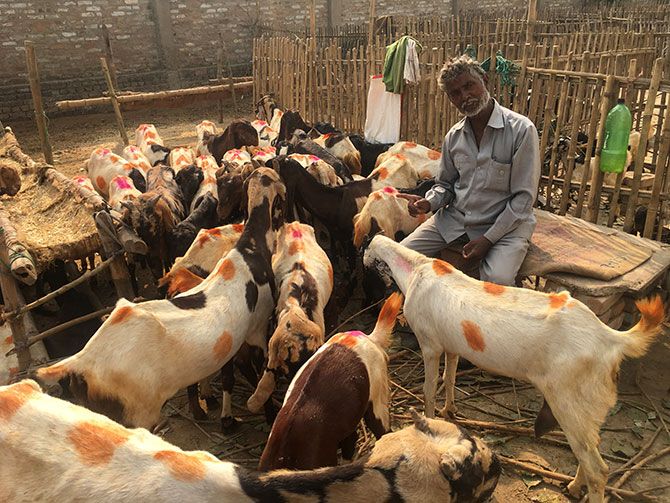
Joharilal Rajaura from Alwar, Rajasthan, has been coming to the mela for 30 years to sell goats.
This year, he brought 155 long-eared goats and has camped here for a month.
Unlike previous years, he is disappointed that he has not been able to sell them all and the mela is coming to an end on December 3.
"I will go on a loss this year, but will not leave till I have sold them all," he says.
This year, he brought 155 long-eared goats and has camped here for a month.
Unlike previous years, he is disappointed that he has not been able to sell them all and the mela is coming to an end on December 3.
"I will go on a loss this year, but will not leave till I have sold them all," he says.
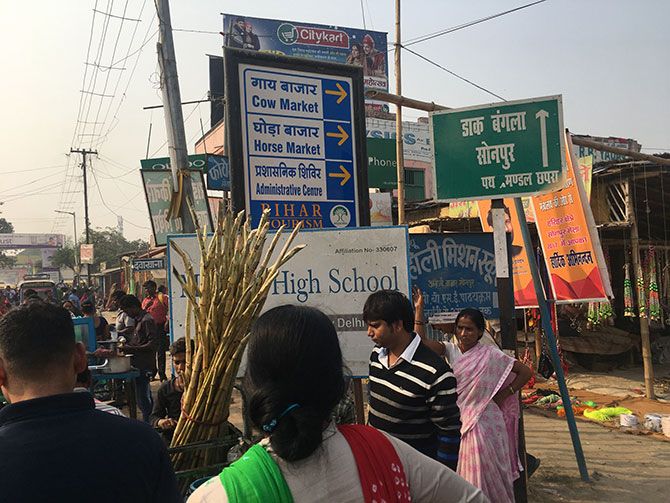
"Chandragupta Maurya, Akbar, Chhatrapati Shivaji, Rani Laxmibai, Kunwar Singh have all bought horses from the mela," says Vishwanath Singh, lawyer and local journalist, who has been coming to the mela since 1966.
A banner inside a craft precinct bears pictures of these names with a short description of their association with the mela.
Kunwar Singh is said to have planned for the revolt of 1857 at the mela.
A banner inside a craft precinct bears pictures of these names with a short description of their association with the mela.
Kunwar Singh is said to have planned for the revolt of 1857 at the mela.
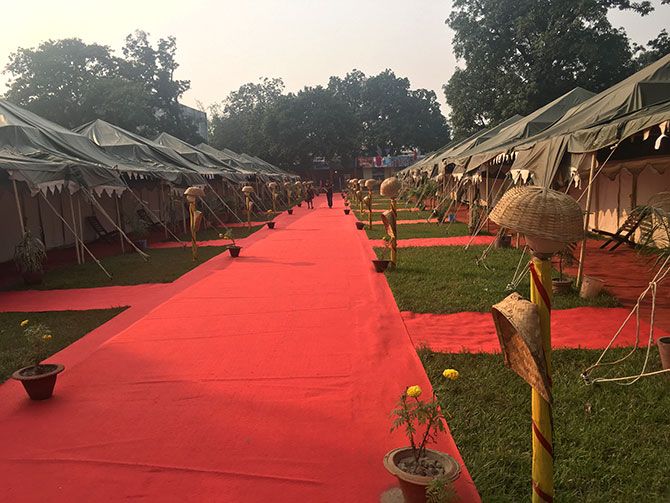
Swiss cottages tents have been brought from Rajasthan by Bihar Tourism for tourists.
The mela begins on Kartik Purnima with a holy dip in the Gandak river.
Elephants, horses, oxen were once amongst the most sold animals.
In earlier years, rajas and zamindars camped here in elaborate tents to exhibit elephants and horses in a game of one upmanship.
Animal laws have now banned elephants from the fair.
The oxen and bull market used to be spread over 30 to 35 acres and lakhs of these animals were up for sale.
With tractors replacing bulls, only around 2,000 bulls came to the fair this time.
Horses were the most sold animals this year.
The ban on inter-state movement of cows has brought down the cow population at the fair.
In earlier times, cattle were sold in such large numbers that buyers booked railway carriages on goods trains for transport.
The mela begins on Kartik Purnima with a holy dip in the Gandak river.
Elephants, horses, oxen were once amongst the most sold animals.
In earlier years, rajas and zamindars camped here in elaborate tents to exhibit elephants and horses in a game of one upmanship.
Animal laws have now banned elephants from the fair.
The oxen and bull market used to be spread over 30 to 35 acres and lakhs of these animals were up for sale.
With tractors replacing bulls, only around 2,000 bulls came to the fair this time.
Horses were the most sold animals this year.
The ban on inter-state movement of cows has brought down the cow population at the fair.
In earlier times, cattle were sold in such large numbers that buyers booked railway carriages on goods trains for transport.
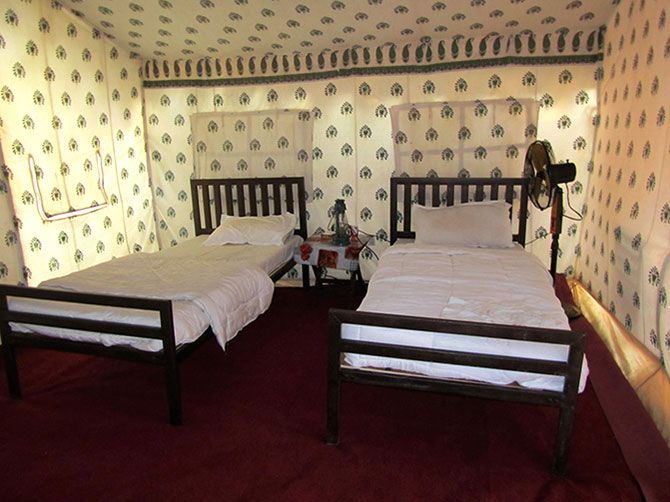
The inside of the tent with an attached bath and toilet. Security at the meial is provided by the Bihar police.
During the initial days the tariff was Rs 7,000 plus 18% GST.
In the last week of the fair, it had come down to Rs 2,500 + GST.
Locals said the tents were never full up to capacity.
Every arm of the state administration is deployed in managing the fair.
In days when communication was limited, the entire district administration would move to camps within the mela precinct for a month.
During the initial days the tariff was Rs 7,000 plus 18% GST.
In the last week of the fair, it had come down to Rs 2,500 + GST.
Locals said the tents were never full up to capacity.
Every arm of the state administration is deployed in managing the fair.
In days when communication was limited, the entire district administration would move to camps within the mela precinct for a month.
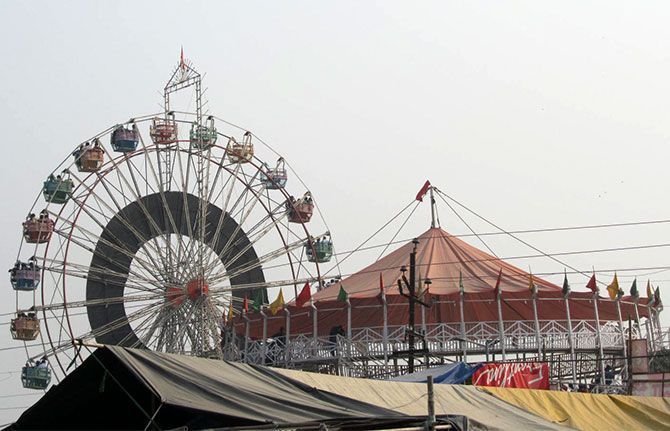
Three ferris wheels rise up in the sky.
The fair has added many elements over the years. It bears a unique rural charm and has 10,000 visitors every day and almost a lakh over the weekend, says the SDO.
Sonepur changes in character and becomes a potpourri of Delhi, Kolkata and Kashmir, says a local.
Sanitation and waste management has to be given attention to prevent disease.
The fair has added many elements over the years. It bears a unique rural charm and has 10,000 visitors every day and almost a lakh over the weekend, says the SDO.
Sonepur changes in character and becomes a potpourri of Delhi, Kolkata and Kashmir, says a local.
Sanitation and waste management has to be given attention to prevent disease.
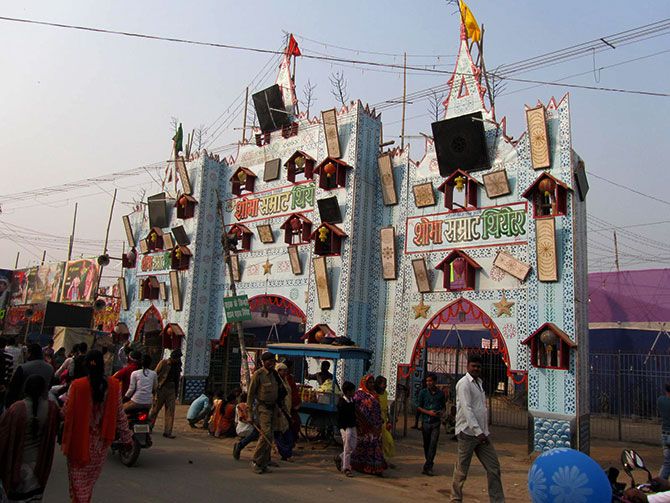
Theatre is the main attraction.
Nine different theatres operate at the fair with at least 100 dancers in each theatre.
The shows begin after 8 pm and go on till the wee hours of the morning.
The audience comes from across the Ganga from Patna and many neighbouring areas.
"Many students from Patna come to see the performances," says Vishwanath, adding that he once did an expose for Dharmyug magazine many years ago about the exploitative nature of the theatre.
Things have changed now -- theatres obtain a license and are monitored by CCTV to ensure that there is no indecent exposure or sexual misconduct, and a magistrate does the rounds, says the subdivisional officer.
Nine different theatres operate at the fair with at least 100 dancers in each theatre.
The shows begin after 8 pm and go on till the wee hours of the morning.
The audience comes from across the Ganga from Patna and many neighbouring areas.
"Many students from Patna come to see the performances," says Vishwanath, adding that he once did an expose for Dharmyug magazine many years ago about the exploitative nature of the theatre.
Things have changed now -- theatres obtain a license and are monitored by CCTV to ensure that there is no indecent exposure or sexual misconduct, and a magistrate does the rounds, says the subdivisional officer.
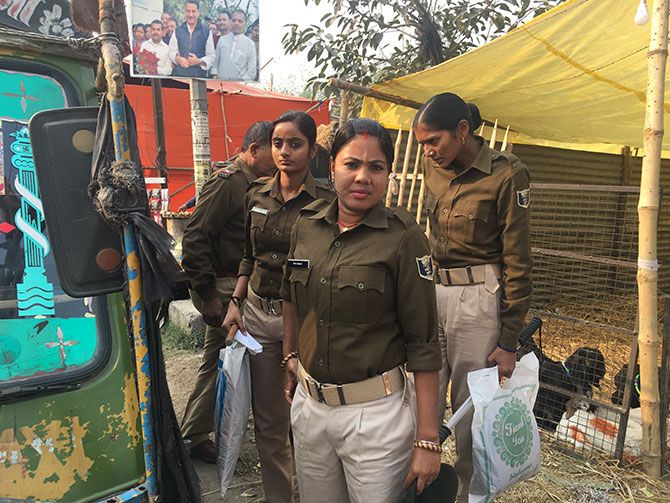
Bihar police personnel stationed at the mela.
Twenty temporary thanas were set up in the first three days of the fair.
2,000 police personnel from across the state were called in for duties.
In the last week of the mela, 6 to 7 temporary police stations still continue to function in the mela area which is spread over government and private land.
Many government departments set up stalls to showcase activities and initiatives -- like the railways, land, agriculture,lLegal awareness etc.
The tourism department sets up a modern stage with the latest sound equipment to stage cultural programmes.
Twenty temporary thanas were set up in the first three days of the fair.
2,000 police personnel from across the state were called in for duties.
In the last week of the mela, 6 to 7 temporary police stations still continue to function in the mela area which is spread over government and private land.
Many government departments set up stalls to showcase activities and initiatives -- like the railways, land, agriculture,lLegal awareness etc.
The tourism department sets up a modern stage with the latest sound equipment to stage cultural programmes.
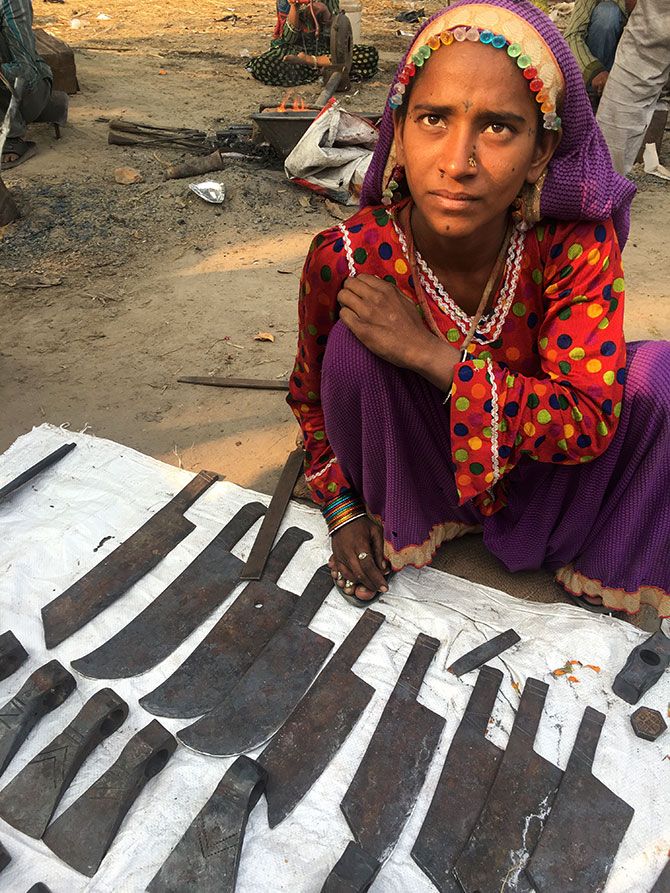
A Gujjar lady sells iron choppers and axe heads.
The women beat the heavy iron into farm tools and sell them on the spot.
Their makeshift shops attracts many people who gather around to watch them make heavy iron tools.
10,000 shop keepers set up shops at the mela for a month.
Bangles, makeup, toys, shawls, woollens, iron safes, flutes, cattle feed, motorcycle and the local mithai chand mithai shaped like a crescent -- most things under the rural sky are available here.
The women beat the heavy iron into farm tools and sell them on the spot.
Their makeshift shops attracts many people who gather around to watch them make heavy iron tools.
10,000 shop keepers set up shops at the mela for a month.
Bangles, makeup, toys, shawls, woollens, iron safes, flutes, cattle feed, motorcycle and the local mithai chand mithai shaped like a crescent -- most things under the rural sky are available here.
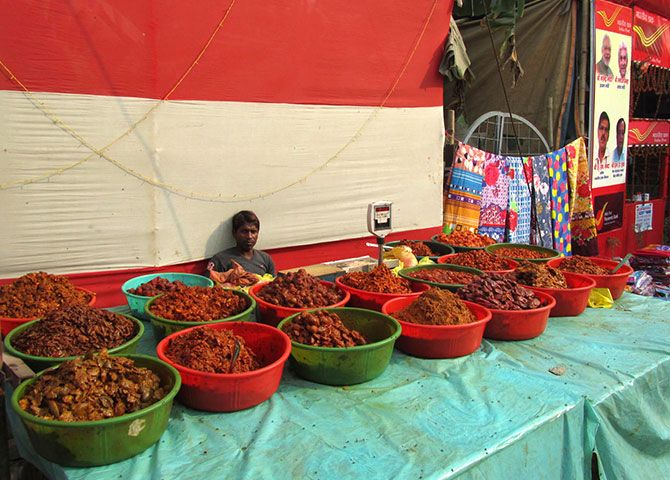
Pickles of different kinds sold in plastic tubs.
The smell of pickles wafts through the air as there are many shops selling achar including mushroom pickle.
The smell of pickles wafts through the air as there are many shops selling achar including mushroom pickle.
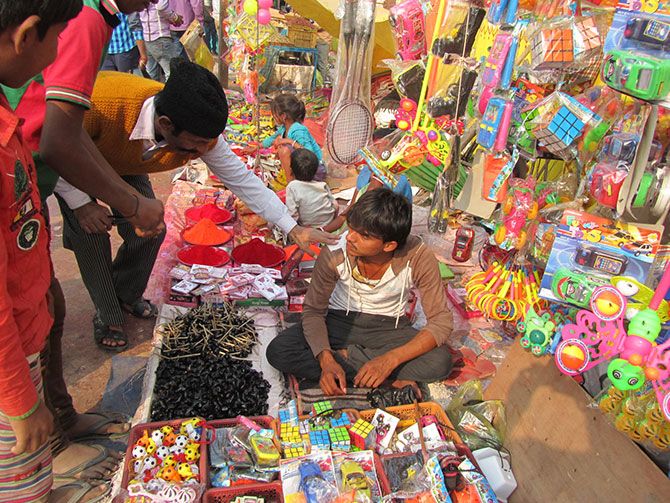
The objects in black are a famous and unique buy from the mela.
These are whistles and tops made of mud.
The boy sells five for Rs 10.
Next to him are mounds of sindoor powder in red, orange and vermillion.
There is hardly a married rural woman without sindoor in the parting of her hair.
These are whistles and tops made of mud.
The boy sells five for Rs 10.
Next to him are mounds of sindoor powder in red, orange and vermillion.
There is hardly a married rural woman without sindoor in the parting of her hair.
A temporary post office in the main mela area.
Letters can be posted from here, and stamps and postage can be bought.
Information about post office schemes can also be obtained.
Letters can be posted from here, and stamps and postage can be bought.
Information about post office schemes can also be obtained.
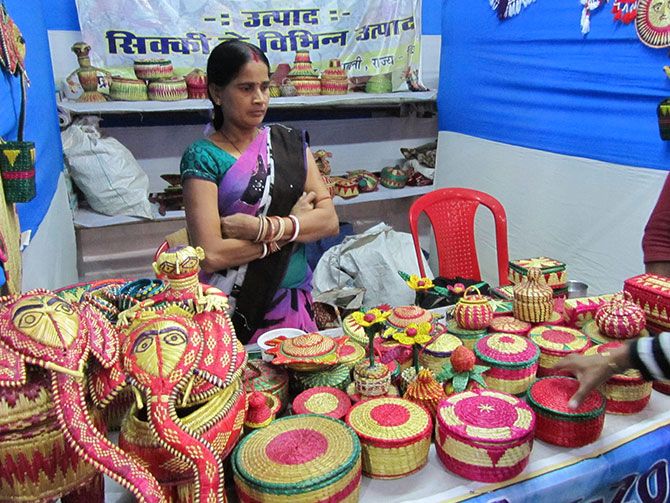
Radha Devi with Ganga Devi have been at their stall of handmade baskets made of dried grass called sikki.
They have traveled from Madhubani, home of the famed art form -- Madhubani painting.
The ladies are persuasive sellers and demand buyers pay the right price for their handiwork.
The stall is in a large precinct dedicated to the Jeevika initiative started by the state government in collaboration with the World Bank to provide self help business initiatives to rural women.
The Jeevika enclosure has shops from 19 districts of Bihar and had earned Rs 7.7 million till this week, adds local journalist Vishwanath Singh.
They have traveled from Madhubani, home of the famed art form -- Madhubani painting.
The ladies are persuasive sellers and demand buyers pay the right price for their handiwork.
The stall is in a large precinct dedicated to the Jeevika initiative started by the state government in collaboration with the World Bank to provide self help business initiatives to rural women.
The Jeevika enclosure has shops from 19 districts of Bihar and had earned Rs 7.7 million till this week, adds local journalist Vishwanath Singh.
A kushti competition underway at the mela.
Various sporting activities like boat races, cricket, football, tug of war takes place during the mela.
A sports village for athletes is also set up.
Earlier, there used to be a mtam race, horse race, even an elephant race -- not any more.
There was also a famous chidiya -- birds -- bazaar and donkey bazaar, especially for washermen -- but there is a complete ban on the sale of birds now.
The stringent animal laws have changed the nature of the fair.
It may no longer draw animals and cattle like it once did, but in its scale, colour and rustic charm, the Sonepur Mela is a mela like no other.
Various sporting activities like boat races, cricket, football, tug of war takes place during the mela.
A sports village for athletes is also set up.
Earlier, there used to be a mtam race, horse race, even an elephant race -- not any more.
There was also a famous chidiya -- birds -- bazaar and donkey bazaar, especially for washermen -- but there is a complete ban on the sale of birds now.
The stringent animal laws have changed the nature of the fair.
It may no longer draw animals and cattle like it once did, but in its scale, colour and rustic charm, the Sonepur Mela is a mela like no other.
